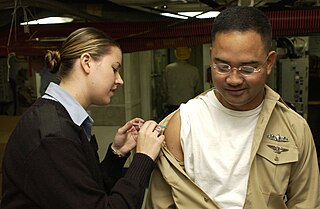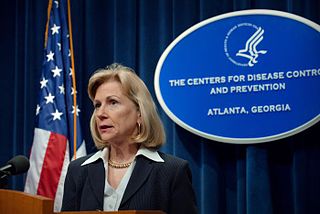National Influenza Centers (also called National Influenza Centres) are institutions which are formally recognized as such by the World Health Organization (WHO). [1]
"The WHO Global Influenza Surveillance Network was established in 1952. The network comprises 4 WHO Collaborating Centres (WHO CCs) and 112 institutions in 83 countries, which are recognized by WHO as WHO National Influenza Centres (NICs). These NICs collect specimens in their country, perform primary virus isolation and preliminary antigenic characterization. They ship newly isolated strains to WHO CCs for high level antigenic and genetic analysis, the result of which forms the basis for WHO recommendations on the composition of influenza vaccine for the Northern and Southern Hemisphere each year."
Among the more than 110 National Influenza Centers [2] are the WHO Collaborating Centres and reference laboratories that are involved in annual influenza vaccine composition recommendations. [3] [4]

Avian influenza, known informally as avian flu or bird flu, is a variety of influenza caused by viruses adapted to birds. The type with the greatest risk is highly pathogenic avian influenza (HPAI). Bird flu is similar to swine flu, dog flu, horse flu and human flu as an illness caused by strains of influenza viruses that have adapted to a specific host. Out of the three types of influenza viruses, influenza A virus is a zoonotic infection with a natural reservoir almost entirely in birds. Avian influenza, for most purposes, refers to the influenza A virus.

Influenza vaccines, also known as flu jabs or flu shots, are vaccines that protect against infection by influenza viruses. New versions of the vaccines are developed twice a year, as the influenza virus rapidly changes. While their effectiveness varies from year to year, most provide modest to high protection against influenza. The United States Centers for Disease Control and Prevention (CDC) estimates that vaccination against influenza reduces sickness, medical visits, hospitalizations, and deaths. Immunized workers who do catch the flu return to work half a day sooner on average. Vaccine effectiveness in those over 65 years old remains uncertain due to a lack of high-quality research. Vaccinating children may protect those around them.
The National Microbiology Laboratory (NML) is part of the Public Health Agency of Canada (PHAC), the agency of the Government of Canada that is responsible for public health, health emergency preparedness and response, and infectious and chronic disease control and prevention.

An influenza pandemic is an epidemic of an influenza virus that spreads across a large region and infects a large proportion of the population. There have been six major influenza epidemics in the last 140 years, with the 1918 flu pandemic being the most severe; this is estimated to have been responsible for the deaths of 50–100 million people. The most recent, the 2009 swine flu pandemic, resulted in under 300,000 deaths and is considered relatively mild. These pandemics occur irregularly.

Influenza A virus subtype H3N2 (A/H3N2) is a subtype of viruses that causes influenza (flu). H3N2 viruses can infect birds and mammals. In birds, humans, and pigs, the virus has mutated into many strains. In years in which H3N2 is the predominant strain, there are more hospitalizations.
OFFLU is the joint OIE-FAO global network of expertise on animal influenzas. OFFLU aims to reduce negative impacts of animal influenza viruses by promoting effective collaboration between animal health experts and with the human health sector. OFFLU puts a strong emphasis on the importance of analysing and sharing information, and biological material to identify and reduce health threats early, and on sharing information about animal influenza viruses with the World Health Organization (WHO) to assist with the early preparation of human vaccines. Since its establishment in 2005, initially to support the global effort to control H5N1 highly pathogenic avian influenza, OFFLU has become a strong and functional network.
World Health Organization collaborating centres are institutions that work with the World Health Organization (WHO) in disciplines such as occupational health, food safety, and communicable disease prevention. There are over 700 such centres across 80 countries. Collaborating centres may be research institutes, parts of universities, or academies. The participating institutions partner with WHO to perform research, provide training, or offer other services in furthering the WHO health agenda. These partners are designated by the WHO director-general as a part of a collaborative network. By using networks of established organizations, WHO is able to strengthen the scientific validity of its work and lower the costs of research.
The Global Health Security Initiative (GHSI) is an informal international partnership among countries in order to exchange information and coordinate practices for confronting new threats and risks to global health. It was formed to respond to threats of biological, chemical, or radio-nuclear terrorism (CBRN), with pandemic influenza added to the scope a year later.

GISAID is a global science initiative and primary source established in 2008 that provides open-access to genomic data of influenza viruses and the coronavirus responsible for the COVID-19 pandemic. On January 10, 2020, the first whole-genome sequences of SARS-CoV-2 were made available on GISAID, which enabled global responses to the pandemic, including the development of the first vaccines and diagnostic tests to detect SARS-CoV-2. GISAID facilitates genomic epidemiology and real-time surveillance to monitor the emergence of new COVID-19 viral strains across the planet.

Nancy J. Cox is an American virologist who has served as the Director of the Influenza Division at the Centers for Disease Control and Prevention (CDC) from 2006 to 2014 and as Director of the CDC's World Health Organization (WHO) Collaborating Center for Surveillance, Epidemiology and Control of Influenza from 1992 to 2014. Cox served as the Chair and Co-Chair of the Scientific Advisory Council of the GISAID Initiative, between the years 2008 and 2017 and is frequently recognized for having played an instrumental role in the success of GISAID.
The National Institute of Virology in Pune, India is an Indian virology research institute and part of the Indian Council of Medical Research (ICMR). It was previously known as 'Virus Research Centre' and was founded in collaboration with the Rockefeller Foundation. It has been designated as a WHO H5 reference laboratory for SE Asia region.
A vaccine-preventable disease is an infectious disease for which an effective preventive vaccine exists. If a person acquires a vaccine-preventable disease and dies from it, the death is considered a vaccine-preventable death.
The Center for Infectious Disease Research and Policy (CIDRAP) is a center within the University of Minnesota that focuses on addressing public health preparedness and emerging infectious disease response. It was founded in 2001 by Michael Osterholm, in order to "prevent illness and death from infectious diseases through epidemiological research and rapid translation of scientific information into real-world practical applications and solutions".

Naval Medical Research Unit Three (NAMRU-3) is a biomedical research laboratory of the US Navy located in Sigonella, Italy. Previously it was located in Cairo, Egypt. NAMRU-3 is the oldest U.S. overseas military medical research facility that has remained in the same location, and one of the largest medical research laboratories in the North Africa-Middle East region. The laboratory has been in continuous operation despite periods of political tension and a seven-year lapse in U.S.-Egyptian relations (1967–1973) since 1942.

Since 1999, the World Health Organization (WHO) has issued annual recommendations for influenza vaccine formulations. One reformulation of the influenza vaccine is for the Northern Hemisphere, and the other is for the Southern Hemisphere. Both recommendations are trivalent, i.e. featuring three strains.
Makerere University Walter Reed Project (MUWRP) was established in 2002 for the primary purpose of HIV vaccine development and building of vaccine testing capability in Uganda. It is one of the 5 international research sites established by the Department of Defense (DoD) United States HIV Research Program (MHRP), a program centered at the Walter Reed Army Institute of Research (WRAIR) in Silver Spring, Maryland. MUWRP’s main facility is centrally located in Kampala, near the Makerere University College of Health Sciences where the MUWRP laboratory is located. The main facility includes the clinic, administrative and data offices.
The Health Protection Surveillance Centre (HPSC) is part of the Health Service Executive. HPSC was set up in 1998 and was formerly known as the National Disease Surveillance Centre (NDSC).
The Institut National de la Recherche Biomédicale (INRB) is the national medical research organization of the Democratic Republic of the Congo. The responsible ministry is the Ministry of Scientific Research and Technology.
The Global Influenza Surveillance and Response System (GISRS) is a global network of laboratories that has for purpose to monitor the spread of influenza with the aim to provide the World Health Organization with influenza control information. It was established in 1952 to conduct global influenza surveillance. GISRS is coordinated by WHO and endorsed by national governments. More than two million respiratory specimens are tested by GISRS annually to monitor the spread and evolution of influenza viruses through a network of about 150 laboratories in 114 countries representing 91% of the world's population. GISRS operates FluNet, an online tool used for virological surveillance of influenza.
The Global Influenza Programme (GIP) is a program launched in 1947 by the World Health Organization with the purpose to provide member states with guidance, support and coordination of activities in order to make their health systems better prepared against seasonal, zoonotic and pandemic influenza threats to populations and individuals. GIP was initiated as one of WHO's initial programs.